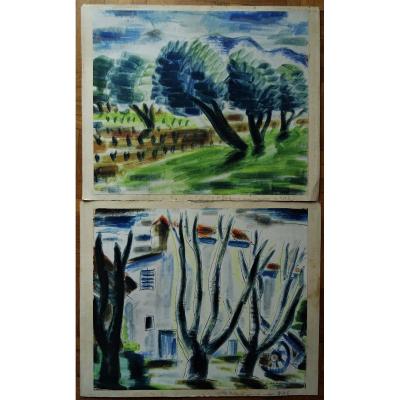"Gio Colucci (1892-1974) "
Very beautiful pair of watercolors by Gio Colucci representing two Fauve Expressionist landscapes, one signed lower right, the other not but with on the back an old label from the famous Galerie De Berri in Paris marked N ° 2104 Colucci. Format of each watercolor alone 31.5x37cm. These are therefore two superb watercolors by Gio Colucci, the first represents a landscape with a cart near a house lined with dead trees, very powerful with a first preparatory drawing in Indian ink that the artist puts then in color in watercolor in shades of green, Prussian blue and red, he also plays a lot with the paper support; the second represents a landscape of vines bordered by trees, more painted than the first because without preparatory drawing, the artist poses directly broad strokes of the brush. We notice in one or the other the great power of the artist with an influence of the Italian Fauves but also of the Germans, movement called Die Brucke. Gio Colucci was born in Florence in 1892 and died in Paris on October 5, 1974 is an Italian painter, engraver, illustrator, ceramicist and sculptor. He entered the École des Beaux-Arts in Paris then moved to Africa before the First World War. He then went to Egypt where he took up the profession of architect in Cairo: he would have built pleasure houses there. After a few paintings inspired by his stay in the Middle East, he turned to abstract painting and returned to France in 1917. His older brother was the writer and publisher Guido Colucci. The Guido and Gio brothers collaborate on a number of books, Guido providing the texts and Gio, the illustrations. As an engraver, Gio Colucci produces etchings and woodcuts. From 1921, he exhibited his engravings in various salons: the Salon d'Automne, then that of the superindependents alongside Gleizes, Herbin, Robert Delaunay, among others. During this period, his work affirms a style close to expressionism, showing a singular energy, flirting with the fantastic. Its palette is wide, its choices controlled. Very involved with French publishers specializing in illustrated books of high bibliophilia, he delivers a series of engravings for texts by Barbey d'Aurevilly, Pierre Loti, Guy de Maupassant, Octave Mirbeau, etc. His masterpiece as an illustrator is Le grant testament de François Villon, of which he made five copies with original color drawings, with calligraphy by his brother Guido. He also became a member, alongside Léopold Survage, Jean Metzinger and Otto Freundlich, of the “electric group” founded by gallery owner Berthe Weill. He also made some advertising posters. In 1928, he exhibited the painting Trois bougres at the Salon d'Automne. Gio Colucci took up ceramics in 1929, and then devoted himself to pottery in a workshop he opened in Aubagne. He moved to 21, rue Montbrun, in the 14th arrondissement of Paris in 1938. In 1939, he joined the Foreign Legion but was taken prisoner by the enemy. He escapes and returns to Aubagne then to Varage, near Aix-en-Provence, in an old tile factory where he turns plates for an old Sicilian potter. He learns to shape utilitarian and traditional ceramics and develops personal creations. Back in Paris in 1945, he presented his work at the Christofle gallery. "Its shapes, inspired5 by its Provençal experiences, are particularly admired: its heavy Louis XV style soup tureens with protruding handles, its large dishes with gadrooned contours are revisited" with a somewhat barbaric exuberance ". These are unique, robust and dense pieces, coated with superimposed enamels, which evoke the bucchero nero of the Etruscans, as evidenced by the brown-black covered pot decorated with orange-yellow enamels preserved in the collections of the Museum of Decorative Arts . In 1955, a major retrospective of his work took place in Paris. In 1960, the International Olympic Committee placed an order for projects of various parts for the games in Rome. In 1956, Gio Colucci and Gino Severini founded the School of Italian Art in Paris: he taught ceramics there. A major retrospective of his work took place in New York in 1959, when he also exhibited at the Rome Quadrennial. He died in 1974 and is buried in the 23rd division of the Parisian cemetery of Thiais. The contents of his workshop were dispersed by the auctioneers Bernard Oger and Étienne Dumont during two auctions at Drouot-Richelieu, Paris, on April 12, 1994 and March 24, 1995. These two watercolors are in good condition, some very slight and tiny scratches in places, I offer them for the moment unframed. I could possibly mismatch them, but I think it will be a shame, but in this case I will be able to sell them for 260 € each. Authentic guarantees



